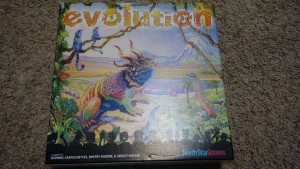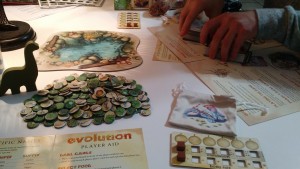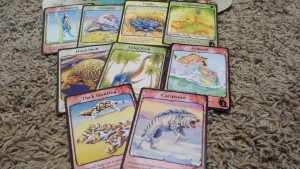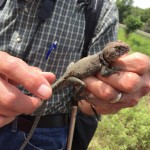Review of Evolution (North Star Games, 2014)
A few weeks back, I posted an article from Nature to the KABT Facebook page reviewing three board games that attempt to model the process of evolution. Brad Williamson was kind enough to make a donation of Nature’s top pick, creatively titled “Evolution”, to me and my classroom. In return, I was asked to write my own review of the game. I’ve had the chance to play Evolution with a number of people: a few of my college biology students, some non-biologist friends, and some biology graduate students. Our gaming groups have ranged in size from just two people to four, with the game supporting up to 6. 
Overall, the goal of Evolution comes down to making the most efficient species at obtaining food. This is done through adding and removing traits that help your species either become improved foragers or carnivores. Food in the game is often limited, leading to competition between your species and those of the other players. Species in the game can have up to three different traits, leading to 12,000 different possible combinations. Each game I’ve played required different strategy due to the large number of possible outcomes.
Efficient species at obtaining food are able to reproduce and grow their population (or have traits that increase reproductive potential). Species with large populations are therefore harder to kill off, but it comes with a major drawback: you have to be able to feed them all. You can also control the body size of your species. This acts as defense against predators for herbivores or offense for carnivores. Other traits allow your species to evolve cooperative or symbiotic relationships with other species in play, helping carnivores hunt or herbivores defend themselves from being eaten. There are also traits that provide defense, such as burrowing, defensive herding, or climbing. With only three traits for each species, you are left with a lot of decisions. Do you build a species that can withstand the attacks of carnivores? Or do you build a species that is an efficient forager? Do you make a more risky, but also aggressive, carnivore? 
During one of my plays, I made tank-like herbivores that could withstand whatever attacks the carnivores could throw at them, but they weren’t great foragers. On turns where plant food was scarce, these defensive animals were facing starvation. Another game with four people, there were a lot of herbivores in play with traits to increase their foraging ability. Once a carnivore came onto the scene, it was able to feed without much to stop it. 
The art of Evolution is beautiful and creative, mixing real animals with imaginary ones. The build-quality is very good and the pieces feel sturdy. The rules are easy to learn, but there is a lot of depth to the gameplay. My students and non-biologist friends were able to pick it up quickly and enjoyed the game.
The game does a great job of modeling the process of natural selection through demonstrating the evolutionary arms race. Species respond to their environment and adapt to changes in order to eat and reproduce. New species arise throughout the game, others go extinct. Other biological concepts are also prevalent, such as carrying capacity, limiting factors, and symbiotic behaviors. Evolution isn’t perfect, however. It is a strategic game, with players controlling how species respond to what other players are doing, and planning future moves, making natural selection feel a little too forward-thinking. If used in the classroom, this would have to be addressed. But overall, the big picture offers a surprisingly good model of evolution. I’ll be requesting a few more copies to use in my classroom, along with the expansion, Flight. If you need a belated Christmas gift for a biology-lover (or board game enthusiast) in your life, I highly recommend Evolution.
 Next Post
Next Post